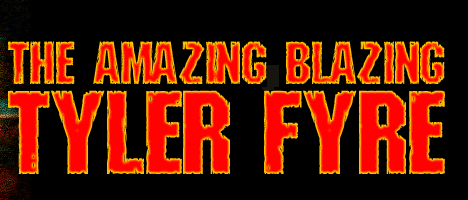Some say the world will end in fire;
Some say in ice.
From what I've tasted of desire
I hold with those who favor fire.
If you have been to Coney Island’s Sideshow by the Seashore — and if you haven’t, you need to get your ass there — you have very likely born witness to the Amazing Blazing Tyler Fyre. In fact, it may very well have been Tyler who enticed you into the show, because one of the many roles that Tyler plays there is that of outside talker (not barker). On the inside you can see him perform a multitude of modern miracles including feats of magic, escapes, the blockhead, sword swallowing, and, of course, fire manipulation. He is a tireless worker devoted to the show and even in those precious few moments he gets away from Coney Island he is always working a stage whether it be with the Bindlestiffs, the Brothers Grimm, or his own side project The Lucky Devil Circus Sideshow.
THE LIZARDMAN: Who are you?
TYLER FYRE: The Amazing Blazing Tyler Fyre! Real name Tyler Fleet — I got my stage name at Silver Lake Waterpark in Raleigh, NC. The sign painter arrived and I had five minutes to think of a name for my show.
THE LIZARDMAN: What first drew you to the sideshow?
TYLER FYRE: You know, it’s a question that seems so easy but I’ve never had a good answer for it. I saw the Ringling Brothers Barnum and Bailey Circus Sideshow as a kid in 1982 at the Omni in Atlanta, GA. Like most kids I thought it was the coolest thing ever. There was also a book my grandparents had — Toby Tyler or 10 weeks with the Circus. Back then (unlike now) Tyler was an uncommon name so a kid in a book with the same name as me was pretty exciting, and he just happened to run away with the circus. I guess you could say those two things planted the seed.
I’ve always been an entertainer at heart — telling stories — doing tricks — and then I got into theater for a while. The thing I’ve come to love about sideshow is not only the amazement factor, but the fact that it appeals to the widest possible demographic. That is, people of all cultures and classes can enjoy the same show.
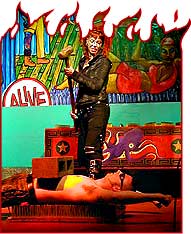
THE LIZARDMAN: How did you ‘break in’?
TYLER FYRE: This is kind of a funny “must be meant to be” kind of story. I was in college for playwriting and had already figured out that it wasn’t really for me. I took Hovey Burgess’s circus class and he taught me how to juggle, walk the tight-rope, do trapeze, and balance things. It was great — from there I met a guy who taught me the basics of fire eating. The next semester I took a street theater class and it just so happened that Jennifer Miller — the bearded lady and Todd Robbins were guest lecturers. Their stories about Coney Island were enthralling.
I made up an act and worked that summer at an amusement park in North Carolina — my first full time gig doing sideshow acts. With a heavy heart I left the south for NYC to finish my degree and once finished I was ready to leave NYC for good. However, I had this stack of tickets from riding my motorcycle like a madman. I went to the DMV in Coney Island to settle all the tickets and was told that my license had been suspended and I could resolve the matter in seven to ten months.
I went for a walk on the beach to calm down and walked past the sideshow. It was closed on weekdays, but the t-shirt vendor next door told me to knock on the door — and five minutes later — out comes Dick Zigun. I say, “I’m the Amazing Blazing Tyler Fyre, I eat fire, pound nails into my head, juggle machetes, walk on stilts, and do magic!”
He checks them off on his fingers like they’re nothing, telling me that all those positions are filled or not needed. “But we do need an outside talker,” he says.
So, I show up to check out the show in full operation, and Dick hands me the microphone and tells me to go to work. With no idea what I’m supposed to do, and having shown up just to check the show out, I take the microphone and they didn’t let me go until ten hours later. That was six years ago.
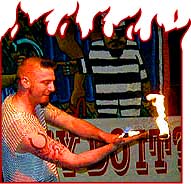
THE LIZARDMAN: What are your body modifications?
TYLER FYRE: I used to have piercings, and still have many of the holes, including the hole in my tongue that I enjoy putting toothpicks in (oh, and that vibrating tongue ring too), but I haven’t worn any jewelry in years. I used to pound a nail through the hole in my tongue, but one day a ten-year-old girl said, “you have a pierced tongue just like my sister,” and I never did the act again.
I’ve got some classic flash-style tattoos on my arms, but all the work is custom originals. I’ve got a pair of angel and devil girls on each upper arm done by Cammille who used to be our blade-box girl in Coney Island. She lives in Austin now, working with Larry Leopard. The angel girl is below my first tattoo of an apple for my hero Johnny Appleseed, with a four-leaf clover for luck. The apple and the angel girl with the snake wrapped around her ankle is my Garden of Eden arm. The right arm has a horseshoe for luck and the cloven-hoofed devil girl with hell-fire and flames. I’ve got a dragonfly from Dragonfly on one hip done at the tattoo convention with my pants down at Roseland. And most recently a firefly from Katzen on the other hip.
I tattooed my cock with “I Want To Rock”. That was a lot of fun actually — my Lucky Devil show was performing at the Forged in Ink tattoo convention in Wyomissing, PA and we all got tattooed on the last day — there I am at the convention getting my dick tattooed as people walk by and say “so, what is that?”
The big one is in fact the first tattoo I ever wanted, and I made myself wait ten years to get it, but I love it. I’ve got red evil eyes tattooed on the back of my head. One side is good, the other side is evil — you decide which is which.
There’s a lot of good and evil in my ink — but there’s a lot of good and evil in all of us.
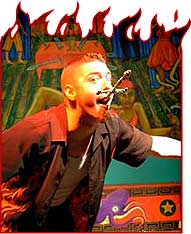
THE LIZARDMAN: Do you use any of your modifications as part of your show (other than general appearance)?
TYLER FYRE: Every now and then I’ll make an eyes in the back of my head joke, but most of the time it’s never mentioned.
THE LIZARDMAN: Would you ever consider getting a modification for solely use onstage (“is this your card?” — and it’s tattooed on your arm)?
TYLER FYRE: You know, I would consider getting a tattoo for stage use... I like joke and optical illusion tattoos, like the dancing hula girls on muscles, Angelica’s [Insectivora at Coney Island and a member of the Lucky Devils] cock that hangs below her knee and that sort of thing, but really, I’m not the tattooed man in the show — and since there is a tattooed man or woman (or often both) at the shows I’m working on — calling attention to my tattoos just seems silly.
THE LIZARDMAN: You work closely and regularly with two heavily (including facially) tattooed people, Eak and Insectivora. What have you noticed about the difference between how people react to them (as audience members or in general) and how they react to you — you are all tattooed, but do they overlook your tattoos next to them, or perhaps act more accepting of your less extensive coverage?
TYLER FYRE: I spend a lot of time with facially and extensively tattooed people. Arty Flash was the first tattooed man I worked with in Coney Island. He was perhaps the nicest about it all — walking to the train after work he would be stopped every ten feet and asked the same questions, he always smiled and talked to everyone — I never saw it bother him. I just finished working with Katzen and The Enigma at the Brothers Grim Sideshow in Texas. We went to the rodeo one night and at the end of the night the cowboys came over and introduced themselves to us and asked us if we wanted to ride a little. It was a great sight to see Katzen and the Enigma up on rodeo horses shaking hands with the cowboys.
Now I work with Eak and Insectavora and we spend a lot of time together at the show, and outside of work too. I’m used to standing right next to them when sideshow fans recognize them from Coney Island and have no idea who I am while they talk about how great the show was. But it’s always funny to me when someone asks about my tattoos while I’m standing next to them. It’s nice to have my work recognized while standing next to such beautiful and extensive living canvases, but I sometimes wonder if it’s the white elephant and it’s just easier to break into the tattoo conversation by talking to me — the safe one.
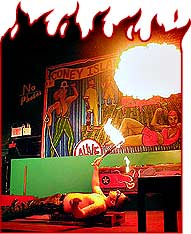
THE LIZARDMAN: Ever want to go the heavily modified route yourself? Perhaps a full bodysuit of flames?
TYLER FYRE: I love tattoos and I have such admiration for my totally tattooed friends. I toyed with a couple ideas of the Slim Goodbody anatomical suit of bones and organs tattooed all over my body. And yes, flame patterns, but really that’s not me. I’m just happy to get to be a part of such a fascinating world.
THE LIZARDMAN: How have your modifications affected your career, if at all — have you gotten or lost gigs due to them?
TYLER FYRE: It’s funny, because I’ve learned a lot about life in the sideshow and working full time as an entertainer — there are certain things you think life will be like, but it’s often a little different. Today I had to get a fax machine and a five foot tall file cabinet. I’m a showman, but somehow I end up doing hours of show-related office work every day. Tattoos are the same way. I thought working in the sideshow I could be as crazy as I wanted — have bright red hair — tattoo full sleeves and anything else — but it’s just not true for me.
When I started at Coney Island I was the outside talker, who is really the go-between for the audience and the human oddities and performers. To do my job well and convince the people to come inside I have to be one of them, not one of the “freaks.” So I’m the one saying “hey, I’m like you, but look how weird this is, look how amazing it is, come inside, it’s safe and you’ll like it.”
In that role I can’t afford to distance myself from the rubes with the way I look. That character and idea helped my performance so much that I’ve never really dropped it. When I’m on stage inside the show I allow my personality to be a little wilder, but at the core of it, looking like the audience allows my acts to hit home harder — as if to say I may have been born just like you but look what happened to me since — and maybe it could happen to you!
I certainly get calls for gigs that I know I’ll have to wear a long sleeve shirt to. I have to think about which promo photos to send out whether they show my tattoos or not. But I’ve done bar mitzvahs in my vest with the naked girl tattoos out in the open — they want the sideshow guy to be “Crazy” but everyone draws that line somewhere differently. I’ve decided to hold off on the elbow and lower arm tattoos I had planned out and stick to less visible areas.

THE LIZARDMAN: I can empathize about buying filing cabinets and office work, do you find that you perhaps underestimated the ‘off stage duties’ that come with being in and running your own shows? Do you think most people realize those aspects of what you do in order to be successful in sideshow (or entertainment overall)?
TYLER FYRE: Working in the sideshow can be the best life in the world, but it is work. In Coney Island, we perform about fifteen shows a day over twelve hours, and anyone who’s worked for Ward Hall or Bobby Reynolds will tell you that they do fifty to seventy shows a day. Now, as much as that fifteenth sword of the day grinds into your throat while you’re looking out at an audience of twenty people (and often less), drunk, making out with their girlfriend, or trying to start a fight with you while you’re on stage — that’s the glamorous part of the sideshow.
After the show is over, you’ve got to pack up your props, take care of the animals, fix anything that broke, sweep and mop the theater, and take out the trash. Oh, you thought we had maids for those tasks right? No, the big stars go from signing breasts after the show to picking up broken beer bottles under the bleachers. Now after you’ve got all that done, and it’s three or four in the morning, then you can start working on that new act you’ve been wanting to put into the show. And like I said, we’ve got it easy in Coney Island — we’re in our own building.
Working under canvas on the mud route is a whole other kind of life. After a three-day spot, you finish the last show at 2 AM, pack up the show, pull the tent stakes, drop and fold the canvas, put it all in the truck, and drive overnight to the next town, sometimes a thousand miles away. And when you get there, you all get motel rooms with room service and jacuzzi’s right? No fucking way, you hop out of the truck, and start pounding tent stakes. Now, these aren’t like the ones for your backyard camping tent — one tent stake weighs twenty pounds and you’re about to pound fifty to a hundred of them into the dried-up, hard-as-a-rock mud, or, if you’re lucky enough to be working a fair on asphalt, then — that’s right — you’re working the jackhammer, and then pounding tent stakes. All so you can perform for three days — maybe ten days — Wow! And then pack it up again.
But for all that work we do in the summer, we all go to Florida and kick back for the winter, right? Myth #467 about the sideshow. Not true. I’m here at home now, surrounded by sideshow banners and props getting a fresh coat of paint. Over the winter it’s a full-time office job of running a business — hiring people for shows, getting props made or repaired, adding up all the receipts, coming up with the new master plan to make more money next year, and figuring out how to book two more shows into fairs you haven’t played before. The work never ends. So, is it Hell to work in the sideshow? No, it’s amazing — you work with the best people in the world, and you get to see places that no ordinary travels would ever take you. And the best part is it’s the most fun you could ever have.

THE LIZARDMAN: The Coney Island schedule can be grueling... I think it is important that people realize that not only are sideshow performers risking themselves with their acts but also through the sheer statistical weight of constant repetition. Do you do anything special in order to keep up with the grind of sword swallowing so many times or doing fire manipulation (slow poisoning) so often?
TYLER FYRE: Oh man, we do so many shows! I just got the stats from this season yesterday. We did almost six hundred shows this season — and that’s just the Coney Island Sideshow — I’m also doing other shows during the summer too — burlesque and rock and roll shows after the sideshow closes — Brothers Grimm and Bar Mitzvahs on my days off (and there are not many days off from the sideshow). Last year I counted and I did almost one thousand shows in a year. I’ll come close this year, but I won’t break a thousand, we had too much rain.
It’s my goal to break a thousand — but it’s a dubious honor. I could be Ozzy Osbourne and do one show a night and be super rich — or I could work in the mud and the dust and try for a thousand. Oh Hell, I love it. But yes, it’s grueling on the body — this year in Coney I was the Human Blockhead, The Sword Swallower, I pitched the blade-box and the blow off, I eat fire, and I did the inverted escape act — tied up by an audience member in a straight jacket then cranked up by my ankles until my head is six feet above the stage. Actually this summer the crank that holds me up broke while I was upside down in a show — but Eak caught the rope! I love that guy.
Yes, it takes an incredible toll on the body. I do what I can to preserve myself for the future — but mostly I do what I can to preserve myself for the fifteen shows I have to do tomorrow. I have to take care of my voice, that’s the big one for me. I take vitamins, I go to the gym, I gargle salt water, and mostly I try and stay in tune with my body so I can fix problems before they get out of hand and make me miss work — because there are no sick days in the sideshow — even if your neon sword breaks in your throat during the first show of the day and cuts you open...
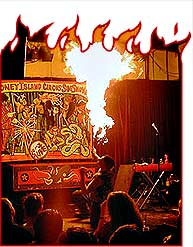
THE LIZARDMAN: Would you suggest the sideshow as a career option to others?
TYLER FYRE: Working in the sideshow is not just a job or even a career — it really is a way of life, and I wouldn’t know what else to do with mine. After the years of grueling training, after starving and selling your soul to learn the skills that may one day kill you, after hours of pounding tent stakes and sweeping the floor— if you make it — there are no days off, no sick days, and try explaining your promotion to the in-laws at the Christmas party. However, if it is the life for you — it’s the best life in the world. It’s about commitment. If you want to be in the sideshow go to the state fair or the carnival that comes through your town and get a job. There’s always work on the carnival.
That’s right, work. Doing “crazy” tricks with your friends at the rock club is not a sideshow. Sideshow is an American folk art rooted in the traveling circus and the carnival. You can’t do sideshow unless you understand how things work on a carnival. There are a lot of kids now who take up sideshow as a hobby and it’s great to see anyone with a love for the sideshow keeping this world alive. But there’s a difference between doing a couple of tricks and being an entertainer. That’s what sideshows are and have always have been — entertainment. Sideshows are not gross-out shows. Like the circus, you don’t have to speak English or read the Playbill to enjoy the sideshow. They’re entertainment for everyone.
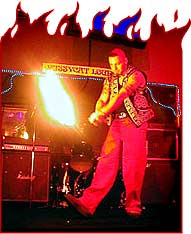
THE LIZARDMAN: What does the word ‘freak’ mean to you?
TYLER FYRE: To me, the word freak is a specific descriptive job title. The word freak has changed meaning substantially since the first half of the 20th century, with the biggest change coming in the 1960’s when the counter-culture adapted “freak” into a badge of honor that separated them from mainstream society. The counter culture then went on to homogenize with the mainstream taking the word freak with it — really stripping the word freak of the strength it once had.
People come up to me after shows all the time and say, “Hey, I’m a freak too!” I know they mean it as a compliment, but it grinds at me every time I hear it. The word freak is a badge of honor to me — but one that’s hard won and often not chosen by those special enough to carry that title. Calling yourself a freak because you have pink hair this week or your mom doesn’t like the music you listen to is like me going into the hospital and saying, “Hey, I’m a doctor too, I put this band-aid on all by myself.”
The word freak describes a person who is visibly physically different than the standard-form human being. Physically deformed people like conjoined twins, bearded ladies, and dwarves are classic examples of freaks, though I believe that amputees and totally tattooed folks fit the category too. Freaks have always been the royalty of the sideshow. Freaks make more money, get better trailers, more press, and let’s face it, are harder to replace than the rest of the cast and crew. But freaks can’t “turn it off” when the work day is over (although in the carnival, it never feels like the work day is actually over).
I am not a freak and never will be. I am a working act. I’ve dedicated my life to learning skills that are amazing on stage — but when I walk out of the sideshow at night, I can put on a hat and be virtually unrecognizable. Freaks are jaw-dropping different not just when they’re on stage — but when they’re getting their morning coffee too. It takes tremendous strength of character to be a freak — and thus, some of the strongest and most interesting people I’ve been honored to know, have been interesting on the outside as well.
 Be sure to visit www.tylerfyre.com and www.coneyisland.com.
Be sure to visit www.tylerfyre.com and www.coneyisland.com.

Erik Sprague
The Lizardman
because the world NEEDS freaks...
Former doctoral candidate and philosophy degree holder Erik Sprague, The Lizardman, is known around the world for his amazing transformation from man to lizard as well as his modern sideshow performance art. Need I say more?
Copyright © 2004 BMEZINE.COM. Requests to republish must be confirmed in writing. For bibliographical purposes this article was first published January 2nd, 2004 by BMEZINE.COM in Tweed, Ontario, Canada. Photos courtesy of TylerFyre.com.
|
 |
View all columns by Erik Sprague | Return to BME/News











